PUBH650 - Peer Support Workers for Homeless and Marginalized People
VerifiedAdded on 2023/06/12
|15
|4445
|250
Report
AI Summary
This report investigates the use of peer support workers for homeless and marginalized people, particularly within the context of the COTTAGE and ALERT programs at St. Vincent's Hospital. It discusses the various factors contributing to homelessness, including poverty, lack of support, mental illness, and drug abuse. The report explores different peer support models, such as the peer worker model (using professionals with lived experience), the peer-peer model (homeless individuals supporting each other), and the use of professionals with personal connections to homelessness. It highlights the benefits and impact of these models in addressing the health challenges faced by homeless individuals in Australia.
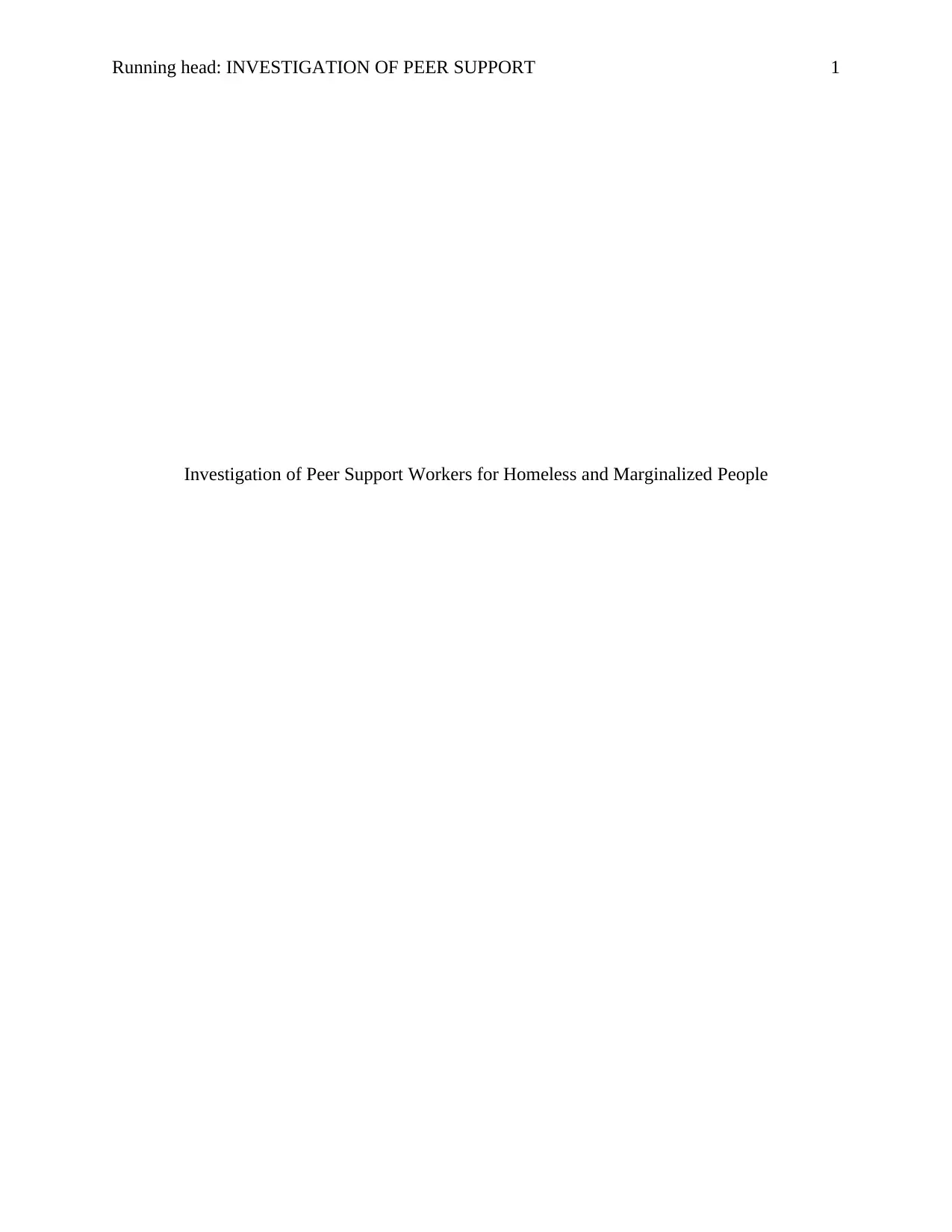
Running head: INVESTIGATION OF PEER SUPPORT 1
Investigation of Peer Support Workers for Homeless and Marginalized People
Investigation of Peer Support Workers for Homeless and Marginalized People
Paraphrase This Document
Need a fresh take? Get an instant paraphrase of this document with our AI Paraphraser
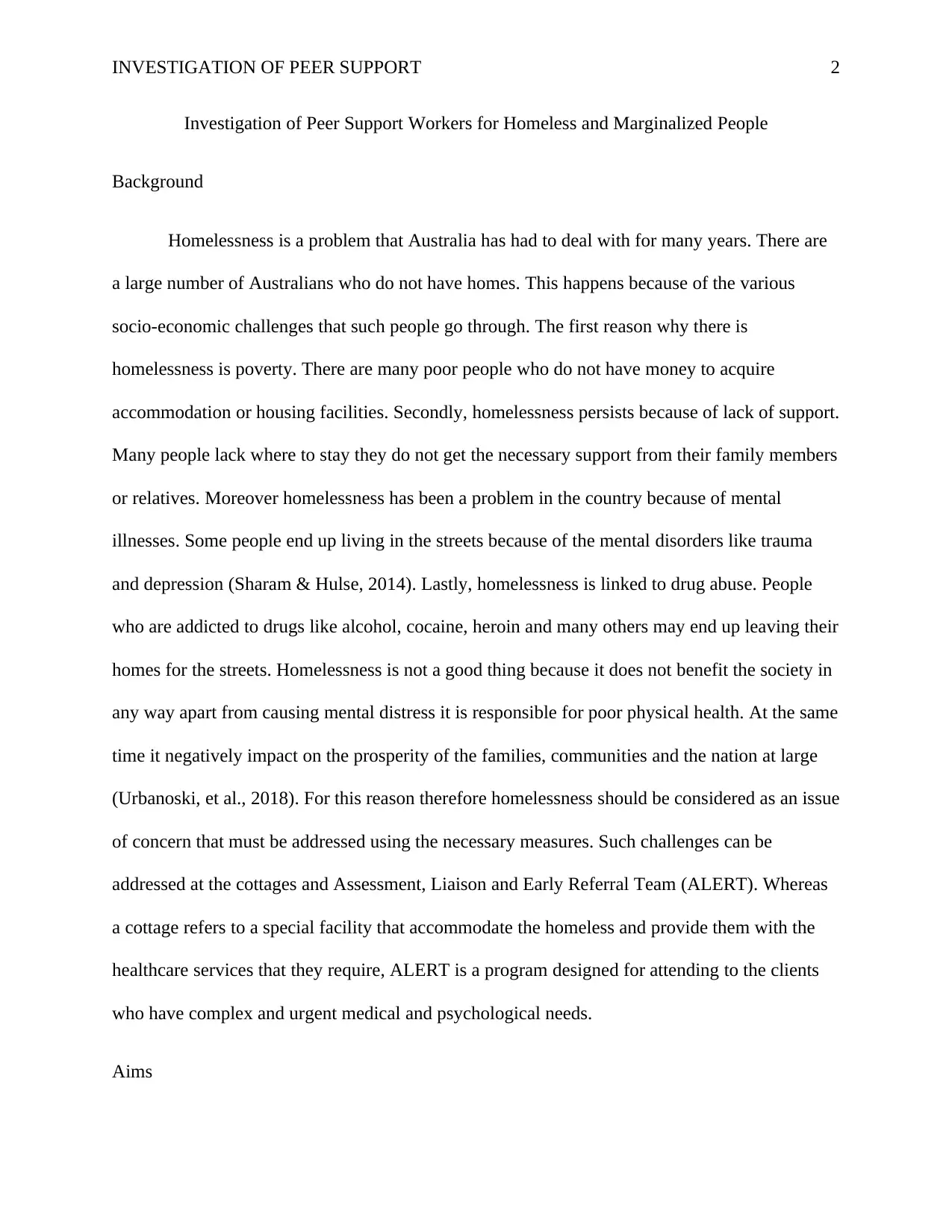
INVESTIGATION OF PEER SUPPORT 2
Investigation of Peer Support Workers for Homeless and Marginalized People
Background
Homelessness is a problem that Australia has had to deal with for many years. There are
a large number of Australians who do not have homes. This happens because of the various
socio-economic challenges that such people go through. The first reason why there is
homelessness is poverty. There are many poor people who do not have money to acquire
accommodation or housing facilities. Secondly, homelessness persists because of lack of support.
Many people lack where to stay they do not get the necessary support from their family members
or relatives. Moreover homelessness has been a problem in the country because of mental
illnesses. Some people end up living in the streets because of the mental disorders like trauma
and depression (Sharam & Hulse, 2014). Lastly, homelessness is linked to drug abuse. People
who are addicted to drugs like alcohol, cocaine, heroin and many others may end up leaving their
homes for the streets. Homelessness is not a good thing because it does not benefit the society in
any way apart from causing mental distress it is responsible for poor physical health. At the same
time it negatively impact on the prosperity of the families, communities and the nation at large
(Urbanoski, et al., 2018). For this reason therefore homelessness should be considered as an issue
of concern that must be addressed using the necessary measures. Such challenges can be
addressed at the cottages and Assessment, Liaison and Early Referral Team (ALERT). Whereas
a cottage refers to a special facility that accommodate the homeless and provide them with the
healthcare services that they require, ALERT is a program designed for attending to the clients
who have complex and urgent medical and psychological needs.
Aims
Investigation of Peer Support Workers for Homeless and Marginalized People
Background
Homelessness is a problem that Australia has had to deal with for many years. There are
a large number of Australians who do not have homes. This happens because of the various
socio-economic challenges that such people go through. The first reason why there is
homelessness is poverty. There are many poor people who do not have money to acquire
accommodation or housing facilities. Secondly, homelessness persists because of lack of support.
Many people lack where to stay they do not get the necessary support from their family members
or relatives. Moreover homelessness has been a problem in the country because of mental
illnesses. Some people end up living in the streets because of the mental disorders like trauma
and depression (Sharam & Hulse, 2014). Lastly, homelessness is linked to drug abuse. People
who are addicted to drugs like alcohol, cocaine, heroin and many others may end up leaving their
homes for the streets. Homelessness is not a good thing because it does not benefit the society in
any way apart from causing mental distress it is responsible for poor physical health. At the same
time it negatively impact on the prosperity of the families, communities and the nation at large
(Urbanoski, et al., 2018). For this reason therefore homelessness should be considered as an issue
of concern that must be addressed using the necessary measures. Such challenges can be
addressed at the cottages and Assessment, Liaison and Early Referral Team (ALERT). Whereas
a cottage refers to a special facility that accommodate the homeless and provide them with the
healthcare services that they require, ALERT is a program designed for attending to the clients
who have complex and urgent medical and psychological needs.
Aims
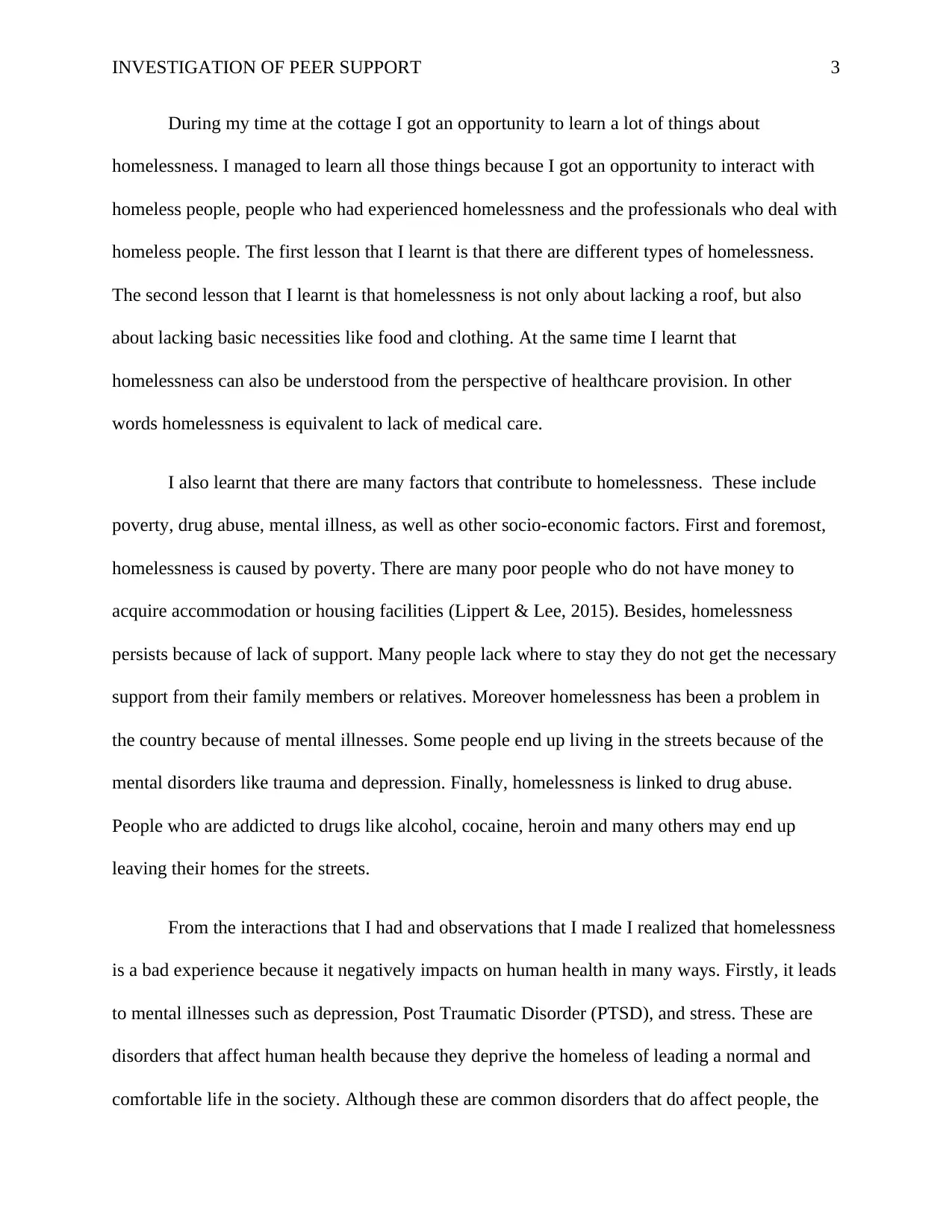
INVESTIGATION OF PEER SUPPORT 3
During my time at the cottage I got an opportunity to learn a lot of things about
homelessness. I managed to learn all those things because I got an opportunity to interact with
homeless people, people who had experienced homelessness and the professionals who deal with
homeless people. The first lesson that I learnt is that there are different types of homelessness.
The second lesson that I learnt is that homelessness is not only about lacking a roof, but also
about lacking basic necessities like food and clothing. At the same time I learnt that
homelessness can also be understood from the perspective of healthcare provision. In other
words homelessness is equivalent to lack of medical care.
I also learnt that there are many factors that contribute to homelessness. These include
poverty, drug abuse, mental illness, as well as other socio-economic factors. First and foremost,
homelessness is caused by poverty. There are many poor people who do not have money to
acquire accommodation or housing facilities (Lippert & Lee, 2015). Besides, homelessness
persists because of lack of support. Many people lack where to stay they do not get the necessary
support from their family members or relatives. Moreover homelessness has been a problem in
the country because of mental illnesses. Some people end up living in the streets because of the
mental disorders like trauma and depression. Finally, homelessness is linked to drug abuse.
People who are addicted to drugs like alcohol, cocaine, heroin and many others may end up
leaving their homes for the streets.
From the interactions that I had and observations that I made I realized that homelessness
is a bad experience because it negatively impacts on human health in many ways. Firstly, it leads
to mental illnesses such as depression, Post Traumatic Disorder (PTSD), and stress. These are
disorders that affect human health because they deprive the homeless of leading a normal and
comfortable life in the society. Although these are common disorders that do affect people, the
During my time at the cottage I got an opportunity to learn a lot of things about
homelessness. I managed to learn all those things because I got an opportunity to interact with
homeless people, people who had experienced homelessness and the professionals who deal with
homeless people. The first lesson that I learnt is that there are different types of homelessness.
The second lesson that I learnt is that homelessness is not only about lacking a roof, but also
about lacking basic necessities like food and clothing. At the same time I learnt that
homelessness can also be understood from the perspective of healthcare provision. In other
words homelessness is equivalent to lack of medical care.
I also learnt that there are many factors that contribute to homelessness. These include
poverty, drug abuse, mental illness, as well as other socio-economic factors. First and foremost,
homelessness is caused by poverty. There are many poor people who do not have money to
acquire accommodation or housing facilities (Lippert & Lee, 2015). Besides, homelessness
persists because of lack of support. Many people lack where to stay they do not get the necessary
support from their family members or relatives. Moreover homelessness has been a problem in
the country because of mental illnesses. Some people end up living in the streets because of the
mental disorders like trauma and depression. Finally, homelessness is linked to drug abuse.
People who are addicted to drugs like alcohol, cocaine, heroin and many others may end up
leaving their homes for the streets.
From the interactions that I had and observations that I made I realized that homelessness
is a bad experience because it negatively impacts on human health in many ways. Firstly, it leads
to mental illnesses such as depression, Post Traumatic Disorder (PTSD), and stress. These are
disorders that affect human health because they deprive the homeless of leading a normal and
comfortable life in the society. Although these are common disorders that do affect people, the
⊘ This is a preview!⊘
Do you want full access?
Subscribe today to unlock all pages.

Trusted by 1+ million students worldwide
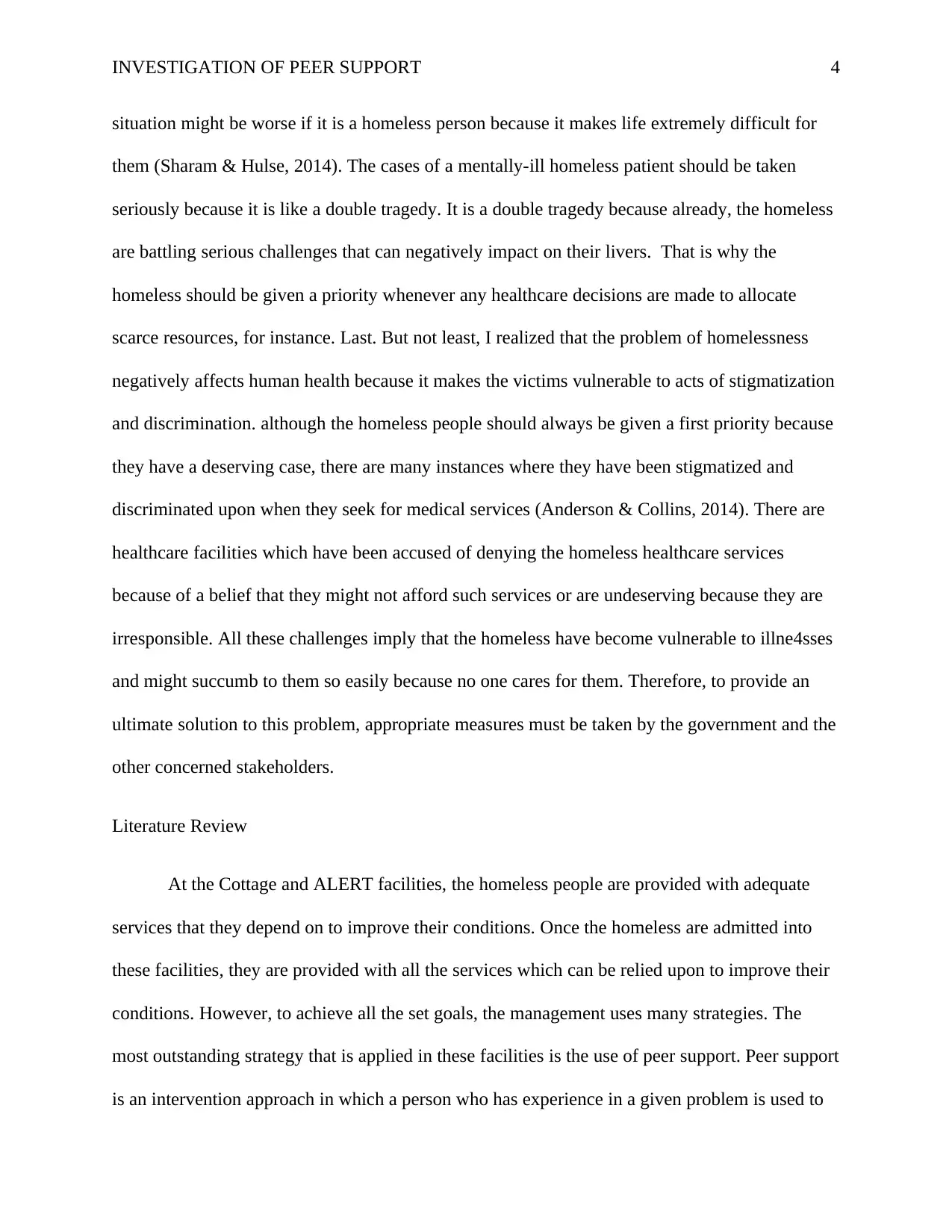
INVESTIGATION OF PEER SUPPORT 4
situation might be worse if it is a homeless person because it makes life extremely difficult for
them (Sharam & Hulse, 2014). The cases of a mentally-ill homeless patient should be taken
seriously because it is like a double tragedy. It is a double tragedy because already, the homeless
are battling serious challenges that can negatively impact on their livers. That is why the
homeless should be given a priority whenever any healthcare decisions are made to allocate
scarce resources, for instance. Last. But not least, I realized that the problem of homelessness
negatively affects human health because it makes the victims vulnerable to acts of stigmatization
and discrimination. although the homeless people should always be given a first priority because
they have a deserving case, there are many instances where they have been stigmatized and
discriminated upon when they seek for medical services (Anderson & Collins, 2014). There are
healthcare facilities which have been accused of denying the homeless healthcare services
because of a belief that they might not afford such services or are undeserving because they are
irresponsible. All these challenges imply that the homeless have become vulnerable to illne4sses
and might succumb to them so easily because no one cares for them. Therefore, to provide an
ultimate solution to this problem, appropriate measures must be taken by the government and the
other concerned stakeholders.
Literature Review
At the Cottage and ALERT facilities, the homeless people are provided with adequate
services that they depend on to improve their conditions. Once the homeless are admitted into
these facilities, they are provided with all the services which can be relied upon to improve their
conditions. However, to achieve all the set goals, the management uses many strategies. The
most outstanding strategy that is applied in these facilities is the use of peer support. Peer support
is an intervention approach in which a person who has experience in a given problem is used to
situation might be worse if it is a homeless person because it makes life extremely difficult for
them (Sharam & Hulse, 2014). The cases of a mentally-ill homeless patient should be taken
seriously because it is like a double tragedy. It is a double tragedy because already, the homeless
are battling serious challenges that can negatively impact on their livers. That is why the
homeless should be given a priority whenever any healthcare decisions are made to allocate
scarce resources, for instance. Last. But not least, I realized that the problem of homelessness
negatively affects human health because it makes the victims vulnerable to acts of stigmatization
and discrimination. although the homeless people should always be given a first priority because
they have a deserving case, there are many instances where they have been stigmatized and
discriminated upon when they seek for medical services (Anderson & Collins, 2014). There are
healthcare facilities which have been accused of denying the homeless healthcare services
because of a belief that they might not afford such services or are undeserving because they are
irresponsible. All these challenges imply that the homeless have become vulnerable to illne4sses
and might succumb to them so easily because no one cares for them. Therefore, to provide an
ultimate solution to this problem, appropriate measures must be taken by the government and the
other concerned stakeholders.
Literature Review
At the Cottage and ALERT facilities, the homeless people are provided with adequate
services that they depend on to improve their conditions. Once the homeless are admitted into
these facilities, they are provided with all the services which can be relied upon to improve their
conditions. However, to achieve all the set goals, the management uses many strategies. The
most outstanding strategy that is applied in these facilities is the use of peer support. Peer support
is an intervention approach in which a person who has experience in a given problem is used to
Paraphrase This Document
Need a fresh take? Get an instant paraphrase of this document with our AI Paraphraser
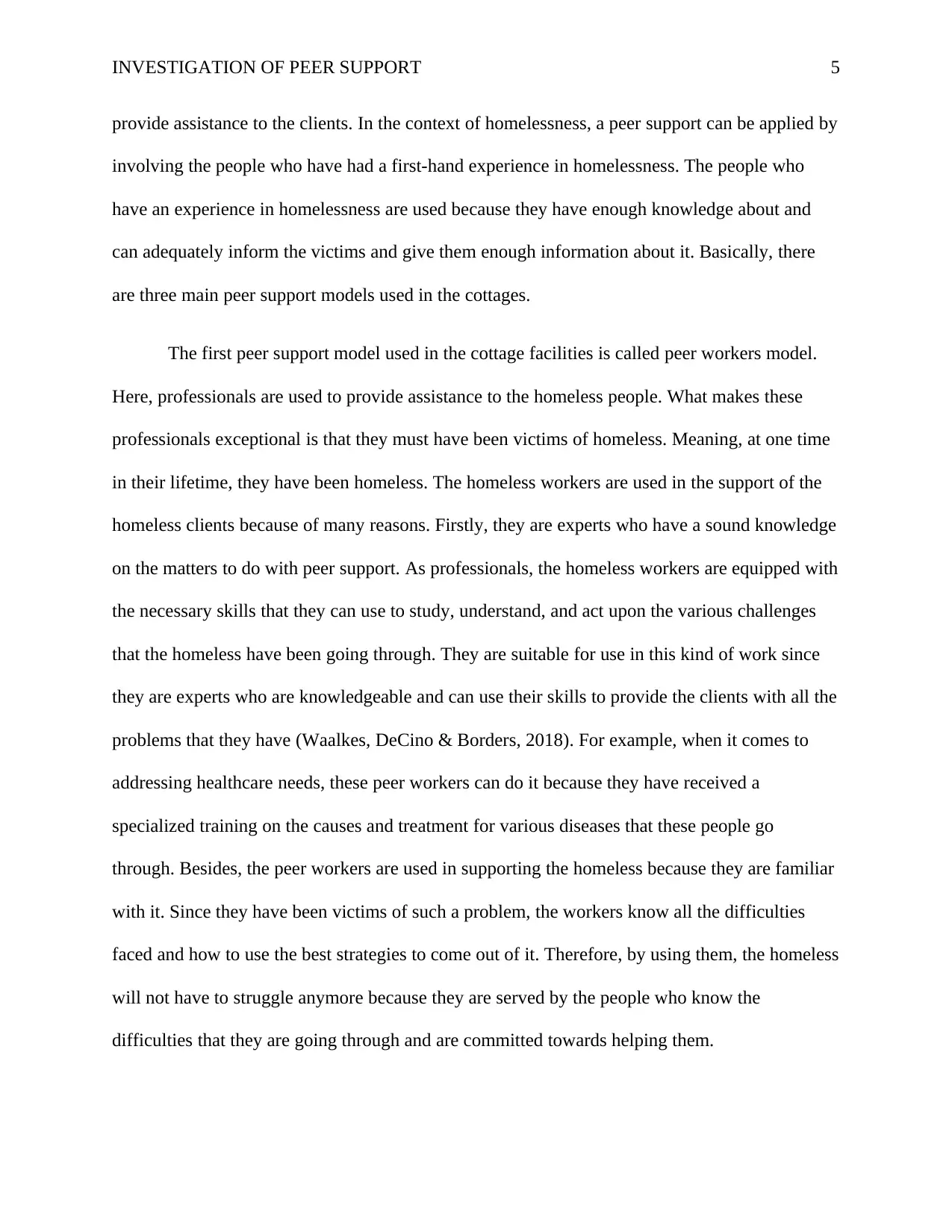
INVESTIGATION OF PEER SUPPORT 5
provide assistance to the clients. In the context of homelessness, a peer support can be applied by
involving the people who have had a first-hand experience in homelessness. The people who
have an experience in homelessness are used because they have enough knowledge about and
can adequately inform the victims and give them enough information about it. Basically, there
are three main peer support models used in the cottages.
The first peer support model used in the cottage facilities is called peer workers model.
Here, professionals are used to provide assistance to the homeless people. What makes these
professionals exceptional is that they must have been victims of homeless. Meaning, at one time
in their lifetime, they have been homeless. The homeless workers are used in the support of the
homeless clients because of many reasons. Firstly, they are experts who have a sound knowledge
on the matters to do with peer support. As professionals, the homeless workers are equipped with
the necessary skills that they can use to study, understand, and act upon the various challenges
that the homeless have been going through. They are suitable for use in this kind of work since
they are experts who are knowledgeable and can use their skills to provide the clients with all the
problems that they have (Waalkes, DeCino & Borders, 2018). For example, when it comes to
addressing healthcare needs, these peer workers can do it because they have received a
specialized training on the causes and treatment for various diseases that these people go
through. Besides, the peer workers are used in supporting the homeless because they are familiar
with it. Since they have been victims of such a problem, the workers know all the difficulties
faced and how to use the best strategies to come out of it. Therefore, by using them, the homeless
will not have to struggle anymore because they are served by the people who know the
difficulties that they are going through and are committed towards helping them.
provide assistance to the clients. In the context of homelessness, a peer support can be applied by
involving the people who have had a first-hand experience in homelessness. The people who
have an experience in homelessness are used because they have enough knowledge about and
can adequately inform the victims and give them enough information about it. Basically, there
are three main peer support models used in the cottages.
The first peer support model used in the cottage facilities is called peer workers model.
Here, professionals are used to provide assistance to the homeless people. What makes these
professionals exceptional is that they must have been victims of homeless. Meaning, at one time
in their lifetime, they have been homeless. The homeless workers are used in the support of the
homeless clients because of many reasons. Firstly, they are experts who have a sound knowledge
on the matters to do with peer support. As professionals, the homeless workers are equipped with
the necessary skills that they can use to study, understand, and act upon the various challenges
that the homeless have been going through. They are suitable for use in this kind of work since
they are experts who are knowledgeable and can use their skills to provide the clients with all the
problems that they have (Waalkes, DeCino & Borders, 2018). For example, when it comes to
addressing healthcare needs, these peer workers can do it because they have received a
specialized training on the causes and treatment for various diseases that these people go
through. Besides, the peer workers are used in supporting the homeless because they are familiar
with it. Since they have been victims of such a problem, the workers know all the difficulties
faced and how to use the best strategies to come out of it. Therefore, by using them, the homeless
will not have to struggle anymore because they are served by the people who know the
difficulties that they are going through and are committed towards helping them.
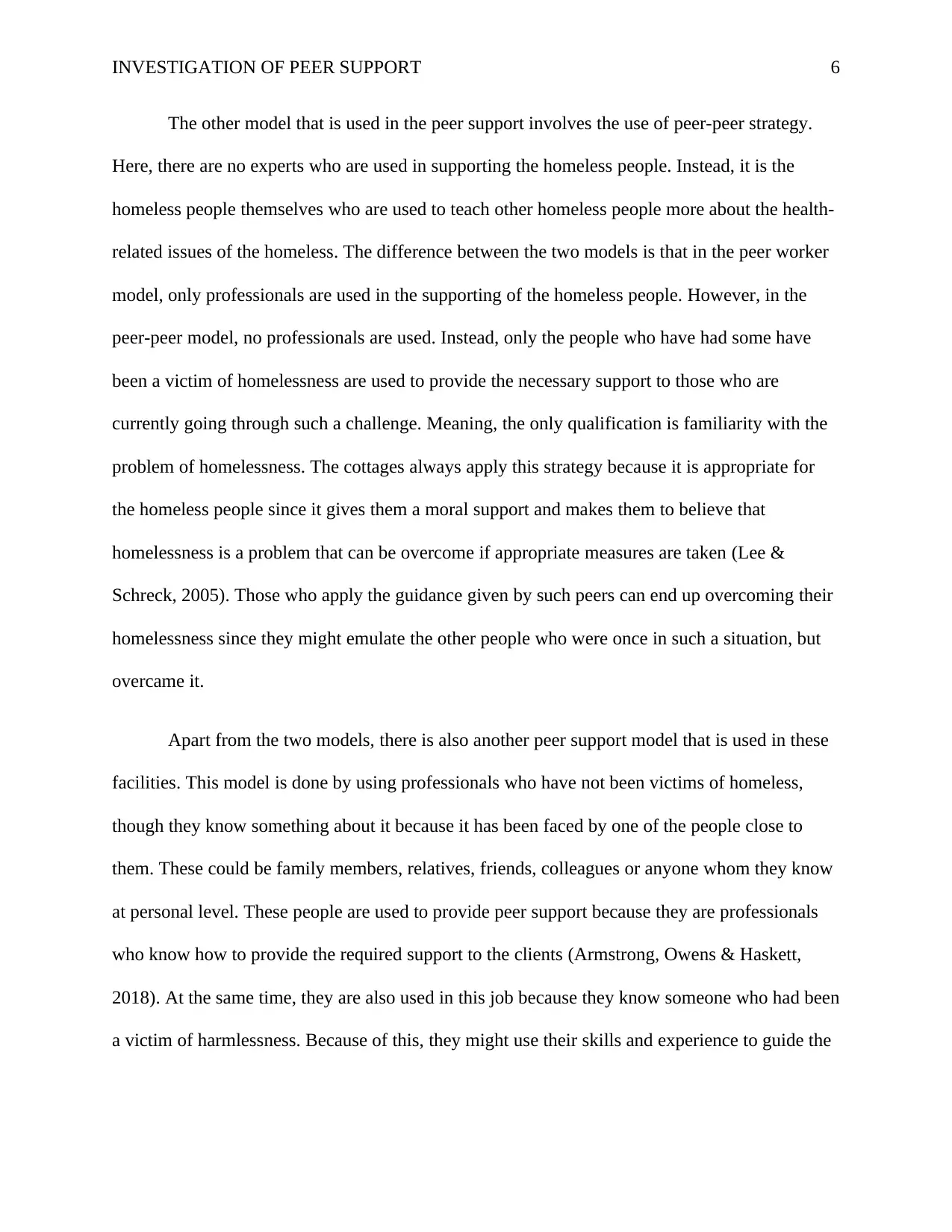
INVESTIGATION OF PEER SUPPORT 6
The other model that is used in the peer support involves the use of peer-peer strategy.
Here, there are no experts who are used in supporting the homeless people. Instead, it is the
homeless people themselves who are used to teach other homeless people more about the health-
related issues of the homeless. The difference between the two models is that in the peer worker
model, only professionals are used in the supporting of the homeless people. However, in the
peer-peer model, no professionals are used. Instead, only the people who have had some have
been a victim of homelessness are used to provide the necessary support to those who are
currently going through such a challenge. Meaning, the only qualification is familiarity with the
problem of homelessness. The cottages always apply this strategy because it is appropriate for
the homeless people since it gives them a moral support and makes them to believe that
homelessness is a problem that can be overcome if appropriate measures are taken (Lee &
Schreck, 2005). Those who apply the guidance given by such peers can end up overcoming their
homelessness since they might emulate the other people who were once in such a situation, but
overcame it.
Apart from the two models, there is also another peer support model that is used in these
facilities. This model is done by using professionals who have not been victims of homeless,
though they know something about it because it has been faced by one of the people close to
them. These could be family members, relatives, friends, colleagues or anyone whom they know
at personal level. These people are used to provide peer support because they are professionals
who know how to provide the required support to the clients (Armstrong, Owens & Haskett,
2018). At the same time, they are also used in this job because they know someone who had been
a victim of harmlessness. Because of this, they might use their skills and experience to guide the
The other model that is used in the peer support involves the use of peer-peer strategy.
Here, there are no experts who are used in supporting the homeless people. Instead, it is the
homeless people themselves who are used to teach other homeless people more about the health-
related issues of the homeless. The difference between the two models is that in the peer worker
model, only professionals are used in the supporting of the homeless people. However, in the
peer-peer model, no professionals are used. Instead, only the people who have had some have
been a victim of homelessness are used to provide the necessary support to those who are
currently going through such a challenge. Meaning, the only qualification is familiarity with the
problem of homelessness. The cottages always apply this strategy because it is appropriate for
the homeless people since it gives them a moral support and makes them to believe that
homelessness is a problem that can be overcome if appropriate measures are taken (Lee &
Schreck, 2005). Those who apply the guidance given by such peers can end up overcoming their
homelessness since they might emulate the other people who were once in such a situation, but
overcame it.
Apart from the two models, there is also another peer support model that is used in these
facilities. This model is done by using professionals who have not been victims of homeless,
though they know something about it because it has been faced by one of the people close to
them. These could be family members, relatives, friends, colleagues or anyone whom they know
at personal level. These people are used to provide peer support because they are professionals
who know how to provide the required support to the clients (Armstrong, Owens & Haskett,
2018). At the same time, they are also used in this job because they know someone who had been
a victim of harmlessness. Because of this, they might use their skills and experience to guide the
⊘ This is a preview!⊘
Do you want full access?
Subscribe today to unlock all pages.

Trusted by 1+ million students worldwide
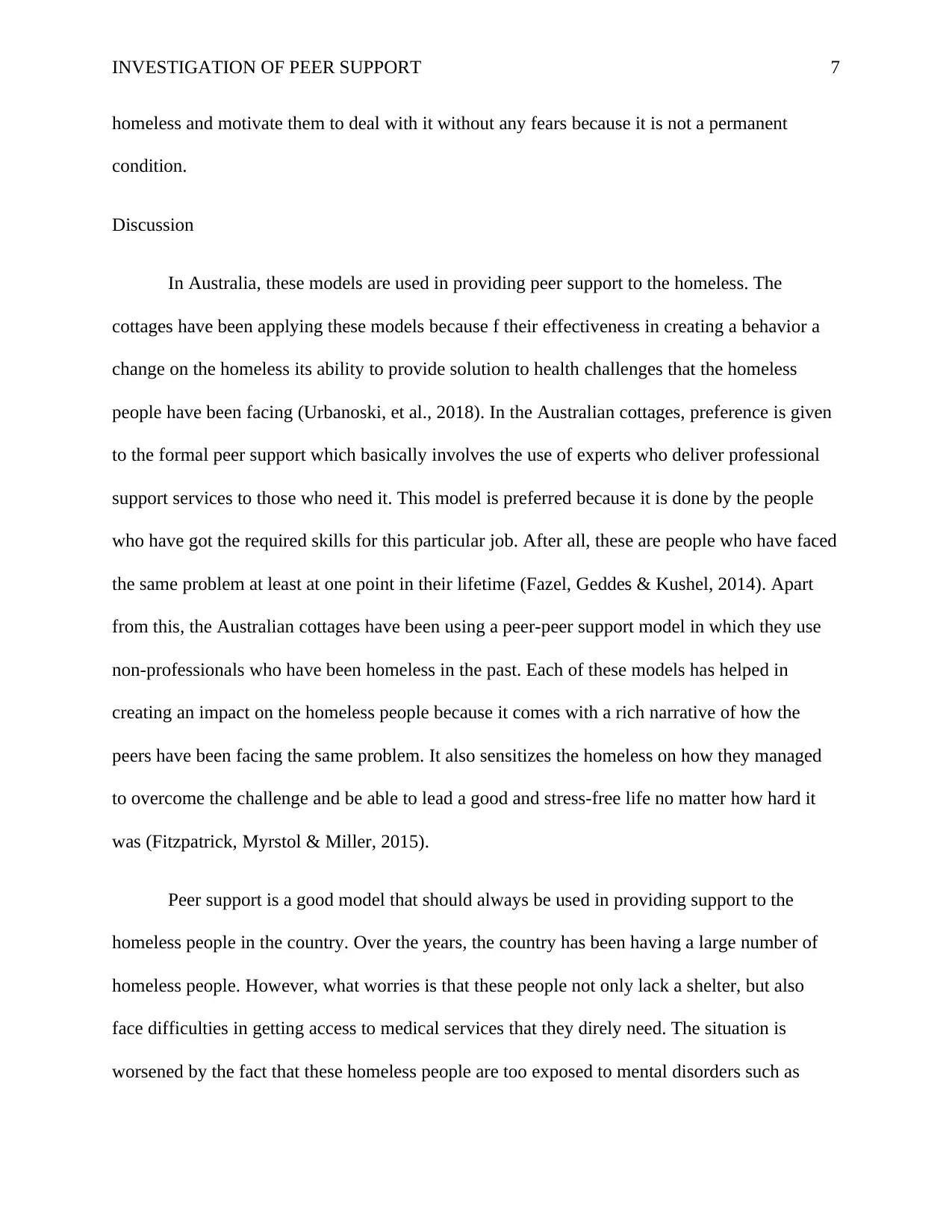
INVESTIGATION OF PEER SUPPORT 7
homeless and motivate them to deal with it without any fears because it is not a permanent
condition.
Discussion
In Australia, these models are used in providing peer support to the homeless. The
cottages have been applying these models because f their effectiveness in creating a behavior a
change on the homeless its ability to provide solution to health challenges that the homeless
people have been facing (Urbanoski, et al., 2018). In the Australian cottages, preference is given
to the formal peer support which basically involves the use of experts who deliver professional
support services to those who need it. This model is preferred because it is done by the people
who have got the required skills for this particular job. After all, these are people who have faced
the same problem at least at one point in their lifetime (Fazel, Geddes & Kushel, 2014). Apart
from this, the Australian cottages have been using a peer-peer support model in which they use
non-professionals who have been homeless in the past. Each of these models has helped in
creating an impact on the homeless people because it comes with a rich narrative of how the
peers have been facing the same problem. It also sensitizes the homeless on how they managed
to overcome the challenge and be able to lead a good and stress-free life no matter how hard it
was (Fitzpatrick, Myrstol & Miller, 2015).
Peer support is a good model that should always be used in providing support to the
homeless people in the country. Over the years, the country has been having a large number of
homeless people. However, what worries is that these people not only lack a shelter, but also
face difficulties in getting access to medical services that they direly need. The situation is
worsened by the fact that these homeless people are too exposed to mental disorders such as
homeless and motivate them to deal with it without any fears because it is not a permanent
condition.
Discussion
In Australia, these models are used in providing peer support to the homeless. The
cottages have been applying these models because f their effectiveness in creating a behavior a
change on the homeless its ability to provide solution to health challenges that the homeless
people have been facing (Urbanoski, et al., 2018). In the Australian cottages, preference is given
to the formal peer support which basically involves the use of experts who deliver professional
support services to those who need it. This model is preferred because it is done by the people
who have got the required skills for this particular job. After all, these are people who have faced
the same problem at least at one point in their lifetime (Fazel, Geddes & Kushel, 2014). Apart
from this, the Australian cottages have been using a peer-peer support model in which they use
non-professionals who have been homeless in the past. Each of these models has helped in
creating an impact on the homeless people because it comes with a rich narrative of how the
peers have been facing the same problem. It also sensitizes the homeless on how they managed
to overcome the challenge and be able to lead a good and stress-free life no matter how hard it
was (Fitzpatrick, Myrstol & Miller, 2015).
Peer support is a good model that should always be used in providing support to the
homeless people in the country. Over the years, the country has been having a large number of
homeless people. However, what worries is that these people not only lack a shelter, but also
face difficulties in getting access to medical services that they direly need. The situation is
worsened by the fact that these homeless people are too exposed to mental disorders such as
Paraphrase This Document
Need a fresh take? Get an instant paraphrase of this document with our AI Paraphraser
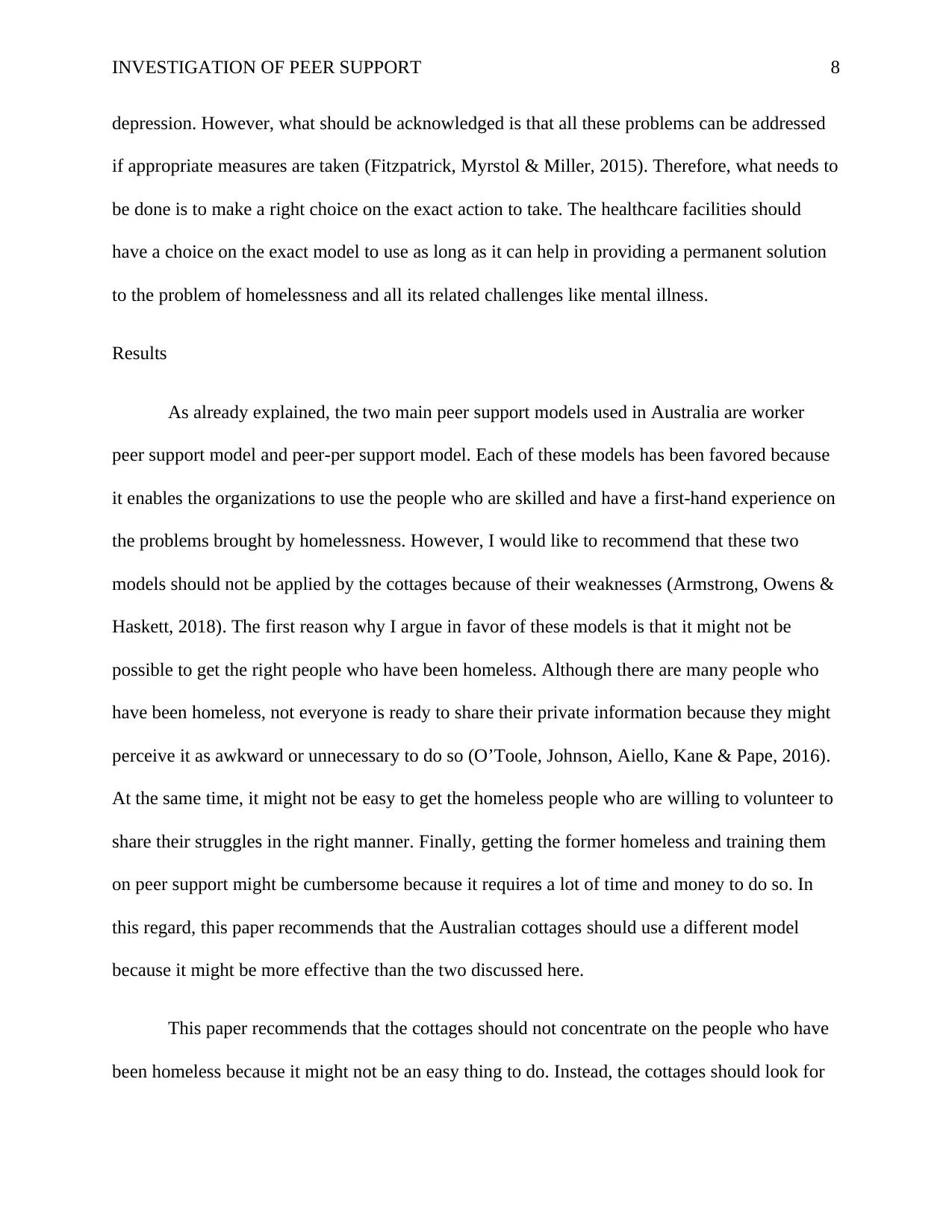
INVESTIGATION OF PEER SUPPORT 8
depression. However, what should be acknowledged is that all these problems can be addressed
if appropriate measures are taken (Fitzpatrick, Myrstol & Miller, 2015). Therefore, what needs to
be done is to make a right choice on the exact action to take. The healthcare facilities should
have a choice on the exact model to use as long as it can help in providing a permanent solution
to the problem of homelessness and all its related challenges like mental illness.
Results
As already explained, the two main peer support models used in Australia are worker
peer support model and peer-per support model. Each of these models has been favored because
it enables the organizations to use the people who are skilled and have a first-hand experience on
the problems brought by homelessness. However, I would like to recommend that these two
models should not be applied by the cottages because of their weaknesses (Armstrong, Owens &
Haskett, 2018). The first reason why I argue in favor of these models is that it might not be
possible to get the right people who have been homeless. Although there are many people who
have been homeless, not everyone is ready to share their private information because they might
perceive it as awkward or unnecessary to do so (O’Toole, Johnson, Aiello, Kane & Pape, 2016).
At the same time, it might not be easy to get the homeless people who are willing to volunteer to
share their struggles in the right manner. Finally, getting the former homeless and training them
on peer support might be cumbersome because it requires a lot of time and money to do so. In
this regard, this paper recommends that the Australian cottages should use a different model
because it might be more effective than the two discussed here.
This paper recommends that the cottages should not concentrate on the people who have
been homeless because it might not be an easy thing to do. Instead, the cottages should look for
depression. However, what should be acknowledged is that all these problems can be addressed
if appropriate measures are taken (Fitzpatrick, Myrstol & Miller, 2015). Therefore, what needs to
be done is to make a right choice on the exact action to take. The healthcare facilities should
have a choice on the exact model to use as long as it can help in providing a permanent solution
to the problem of homelessness and all its related challenges like mental illness.
Results
As already explained, the two main peer support models used in Australia are worker
peer support model and peer-per support model. Each of these models has been favored because
it enables the organizations to use the people who are skilled and have a first-hand experience on
the problems brought by homelessness. However, I would like to recommend that these two
models should not be applied by the cottages because of their weaknesses (Armstrong, Owens &
Haskett, 2018). The first reason why I argue in favor of these models is that it might not be
possible to get the right people who have been homeless. Although there are many people who
have been homeless, not everyone is ready to share their private information because they might
perceive it as awkward or unnecessary to do so (O’Toole, Johnson, Aiello, Kane & Pape, 2016).
At the same time, it might not be easy to get the homeless people who are willing to volunteer to
share their struggles in the right manner. Finally, getting the former homeless and training them
on peer support might be cumbersome because it requires a lot of time and money to do so. In
this regard, this paper recommends that the Australian cottages should use a different model
because it might be more effective than the two discussed here.
This paper recommends that the cottages should not concentrate on the people who have
been homeless because it might not be an easy thing to do. Instead, the cottages should look for
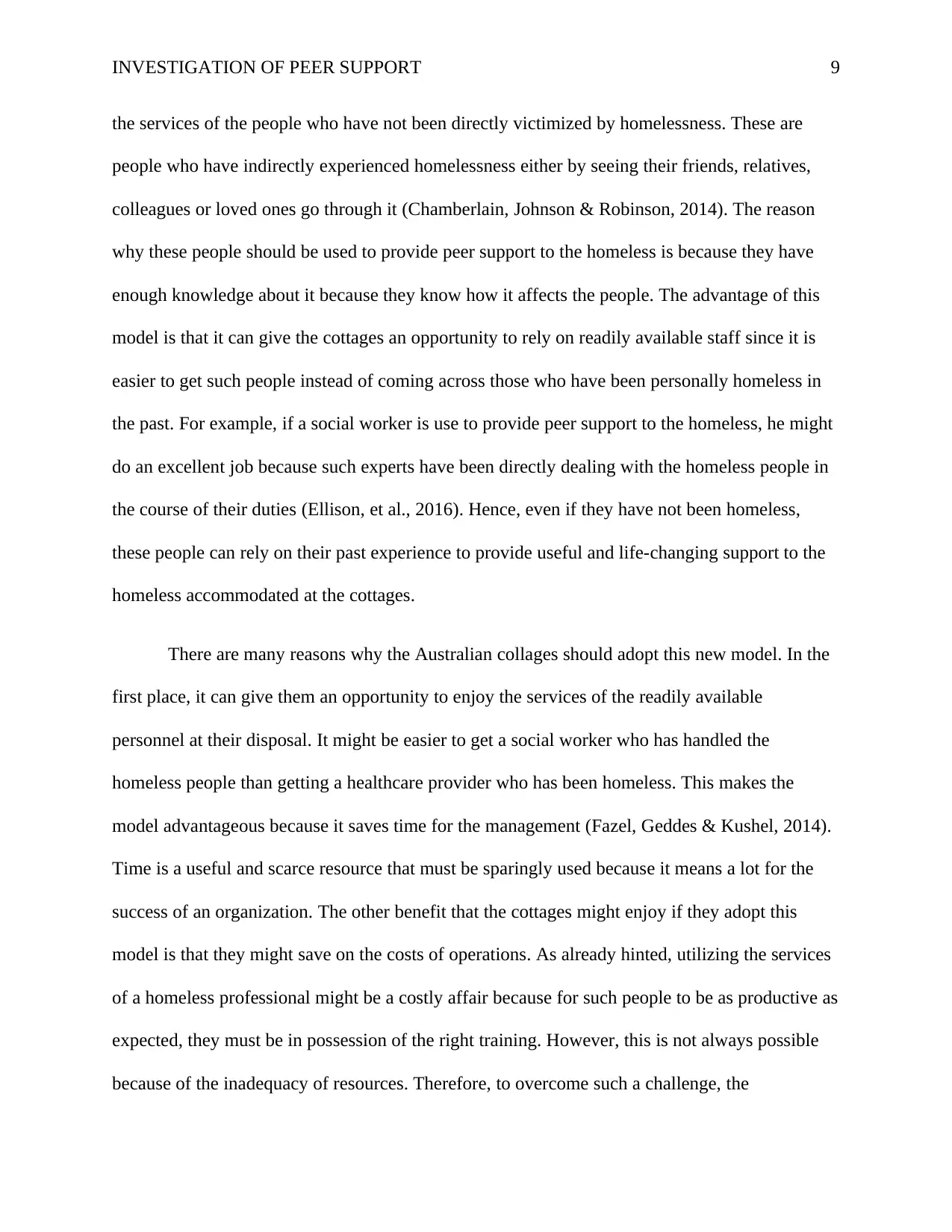
INVESTIGATION OF PEER SUPPORT 9
the services of the people who have not been directly victimized by homelessness. These are
people who have indirectly experienced homelessness either by seeing their friends, relatives,
colleagues or loved ones go through it (Chamberlain, Johnson & Robinson, 2014). The reason
why these people should be used to provide peer support to the homeless is because they have
enough knowledge about it because they know how it affects the people. The advantage of this
model is that it can give the cottages an opportunity to rely on readily available staff since it is
easier to get such people instead of coming across those who have been personally homeless in
the past. For example, if a social worker is use to provide peer support to the homeless, he might
do an excellent job because such experts have been directly dealing with the homeless people in
the course of their duties (Ellison, et al., 2016). Hence, even if they have not been homeless,
these people can rely on their past experience to provide useful and life-changing support to the
homeless accommodated at the cottages.
There are many reasons why the Australian collages should adopt this new model. In the
first place, it can give them an opportunity to enjoy the services of the readily available
personnel at their disposal. It might be easier to get a social worker who has handled the
homeless people than getting a healthcare provider who has been homeless. This makes the
model advantageous because it saves time for the management (Fazel, Geddes & Kushel, 2014).
Time is a useful and scarce resource that must be sparingly used because it means a lot for the
success of an organization. The other benefit that the cottages might enjoy if they adopt this
model is that they might save on the costs of operations. As already hinted, utilizing the services
of a homeless professional might be a costly affair because for such people to be as productive as
expected, they must be in possession of the right training. However, this is not always possible
because of the inadequacy of resources. Therefore, to overcome such a challenge, the
the services of the people who have not been directly victimized by homelessness. These are
people who have indirectly experienced homelessness either by seeing their friends, relatives,
colleagues or loved ones go through it (Chamberlain, Johnson & Robinson, 2014). The reason
why these people should be used to provide peer support to the homeless is because they have
enough knowledge about it because they know how it affects the people. The advantage of this
model is that it can give the cottages an opportunity to rely on readily available staff since it is
easier to get such people instead of coming across those who have been personally homeless in
the past. For example, if a social worker is use to provide peer support to the homeless, he might
do an excellent job because such experts have been directly dealing with the homeless people in
the course of their duties (Ellison, et al., 2016). Hence, even if they have not been homeless,
these people can rely on their past experience to provide useful and life-changing support to the
homeless accommodated at the cottages.
There are many reasons why the Australian collages should adopt this new model. In the
first place, it can give them an opportunity to enjoy the services of the readily available
personnel at their disposal. It might be easier to get a social worker who has handled the
homeless people than getting a healthcare provider who has been homeless. This makes the
model advantageous because it saves time for the management (Fazel, Geddes & Kushel, 2014).
Time is a useful and scarce resource that must be sparingly used because it means a lot for the
success of an organization. The other benefit that the cottages might enjoy if they adopt this
model is that they might save on the costs of operations. As already hinted, utilizing the services
of a homeless professional might be a costly affair because for such people to be as productive as
expected, they must be in possession of the right training. However, this is not always possible
because of the inadequacy of resources. Therefore, to overcome such a challenge, the
⊘ This is a preview!⊘
Do you want full access?
Subscribe today to unlock all pages.

Trusted by 1+ million students worldwide
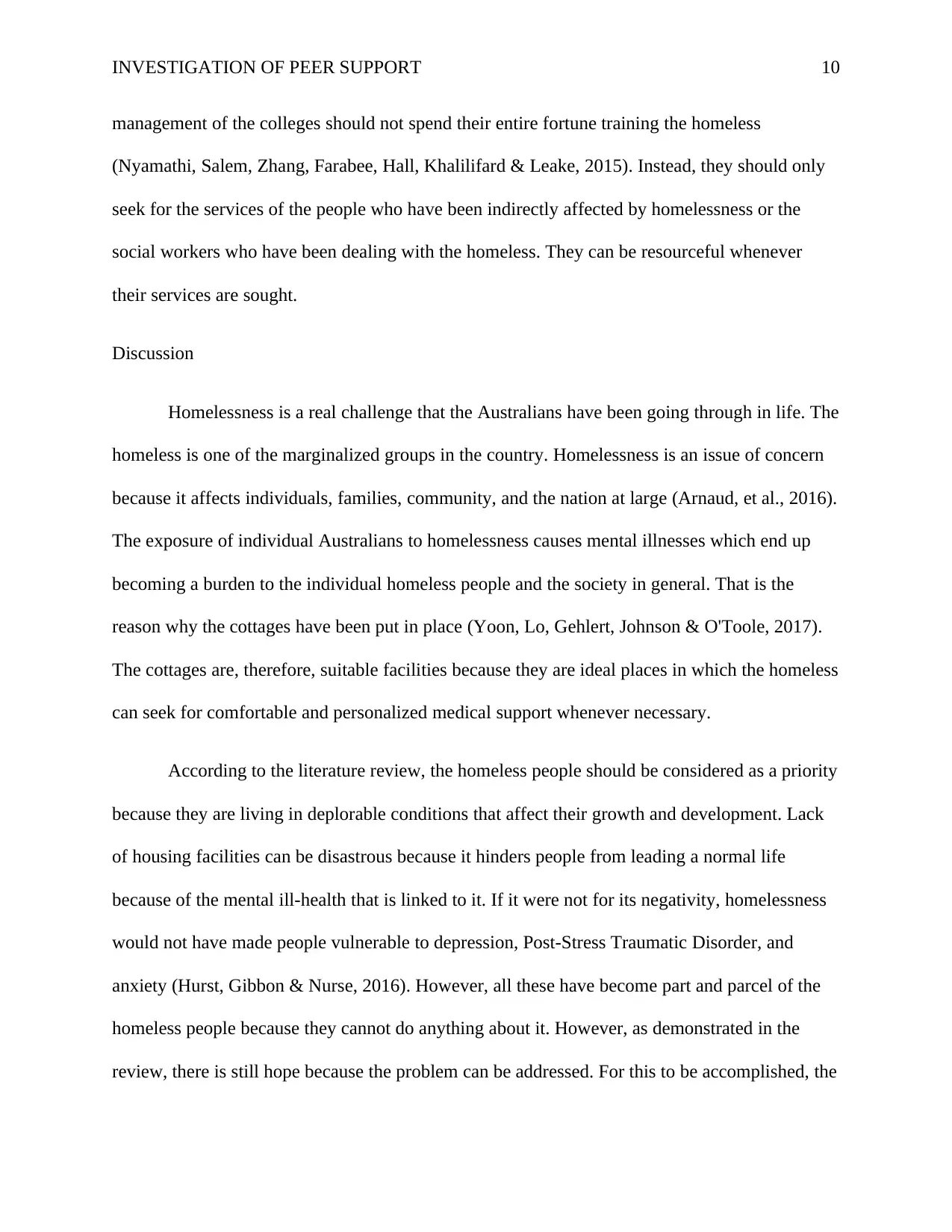
INVESTIGATION OF PEER SUPPORT 10
management of the colleges should not spend their entire fortune training the homeless
(Nyamathi, Salem, Zhang, Farabee, Hall, Khalilifard & Leake, 2015). Instead, they should only
seek for the services of the people who have been indirectly affected by homelessness or the
social workers who have been dealing with the homeless. They can be resourceful whenever
their services are sought.
Discussion
Homelessness is a real challenge that the Australians have been going through in life. The
homeless is one of the marginalized groups in the country. Homelessness is an issue of concern
because it affects individuals, families, community, and the nation at large (Arnaud, et al., 2016).
The exposure of individual Australians to homelessness causes mental illnesses which end up
becoming a burden to the individual homeless people and the society in general. That is the
reason why the cottages have been put in place (Yoon, Lo, Gehlert, Johnson & O'Toole, 2017).
The cottages are, therefore, suitable facilities because they are ideal places in which the homeless
can seek for comfortable and personalized medical support whenever necessary.
According to the literature review, the homeless people should be considered as a priority
because they are living in deplorable conditions that affect their growth and development. Lack
of housing facilities can be disastrous because it hinders people from leading a normal life
because of the mental ill-health that is linked to it. If it were not for its negativity, homelessness
would not have made people vulnerable to depression, Post-Stress Traumatic Disorder, and
anxiety (Hurst, Gibbon & Nurse, 2016). However, all these have become part and parcel of the
homeless people because they cannot do anything about it. However, as demonstrated in the
review, there is still hope because the problem can be addressed. For this to be accomplished, the
management of the colleges should not spend their entire fortune training the homeless
(Nyamathi, Salem, Zhang, Farabee, Hall, Khalilifard & Leake, 2015). Instead, they should only
seek for the services of the people who have been indirectly affected by homelessness or the
social workers who have been dealing with the homeless. They can be resourceful whenever
their services are sought.
Discussion
Homelessness is a real challenge that the Australians have been going through in life. The
homeless is one of the marginalized groups in the country. Homelessness is an issue of concern
because it affects individuals, families, community, and the nation at large (Arnaud, et al., 2016).
The exposure of individual Australians to homelessness causes mental illnesses which end up
becoming a burden to the individual homeless people and the society in general. That is the
reason why the cottages have been put in place (Yoon, Lo, Gehlert, Johnson & O'Toole, 2017).
The cottages are, therefore, suitable facilities because they are ideal places in which the homeless
can seek for comfortable and personalized medical support whenever necessary.
According to the literature review, the homeless people should be considered as a priority
because they are living in deplorable conditions that affect their growth and development. Lack
of housing facilities can be disastrous because it hinders people from leading a normal life
because of the mental ill-health that is linked to it. If it were not for its negativity, homelessness
would not have made people vulnerable to depression, Post-Stress Traumatic Disorder, and
anxiety (Hurst, Gibbon & Nurse, 2016). However, all these have become part and parcel of the
homeless people because they cannot do anything about it. However, as demonstrated in the
review, there is still hope because the problem can be addressed. For this to be accomplished, the
Paraphrase This Document
Need a fresh take? Get an instant paraphrase of this document with our AI Paraphraser
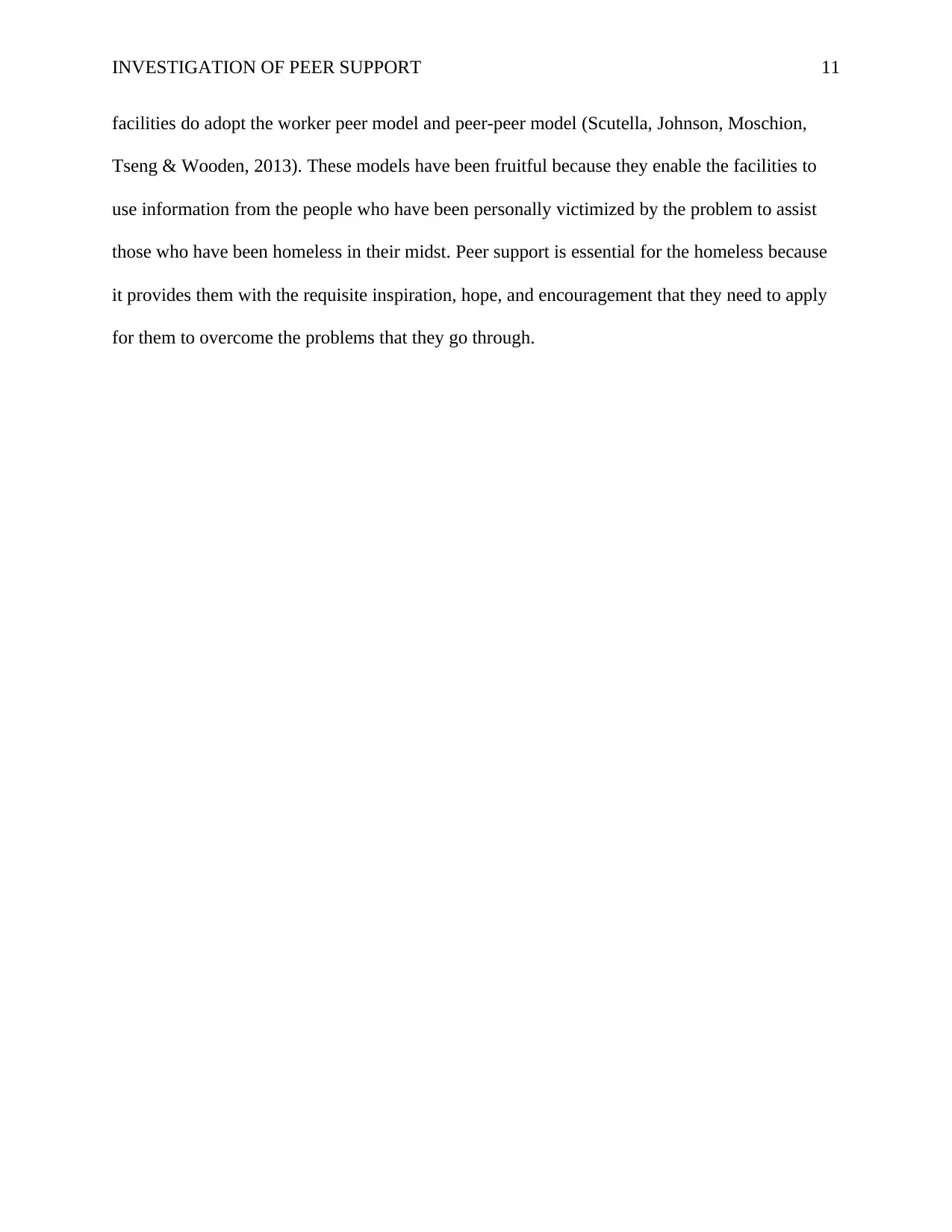
INVESTIGATION OF PEER SUPPORT 11
facilities do adopt the worker peer model and peer-peer model (Scutella, Johnson, Moschion,
Tseng & Wooden, 2013). These models have been fruitful because they enable the facilities to
use information from the people who have been personally victimized by the problem to assist
those who have been homeless in their midst. Peer support is essential for the homeless because
it provides them with the requisite inspiration, hope, and encouragement that they need to apply
for them to overcome the problems that they go through.
facilities do adopt the worker peer model and peer-peer model (Scutella, Johnson, Moschion,
Tseng & Wooden, 2013). These models have been fruitful because they enable the facilities to
use information from the people who have been personally victimized by the problem to assist
those who have been homeless in their midst. Peer support is essential for the homeless because
it provides them with the requisite inspiration, hope, and encouragement that they need to apply
for them to overcome the problems that they go through.
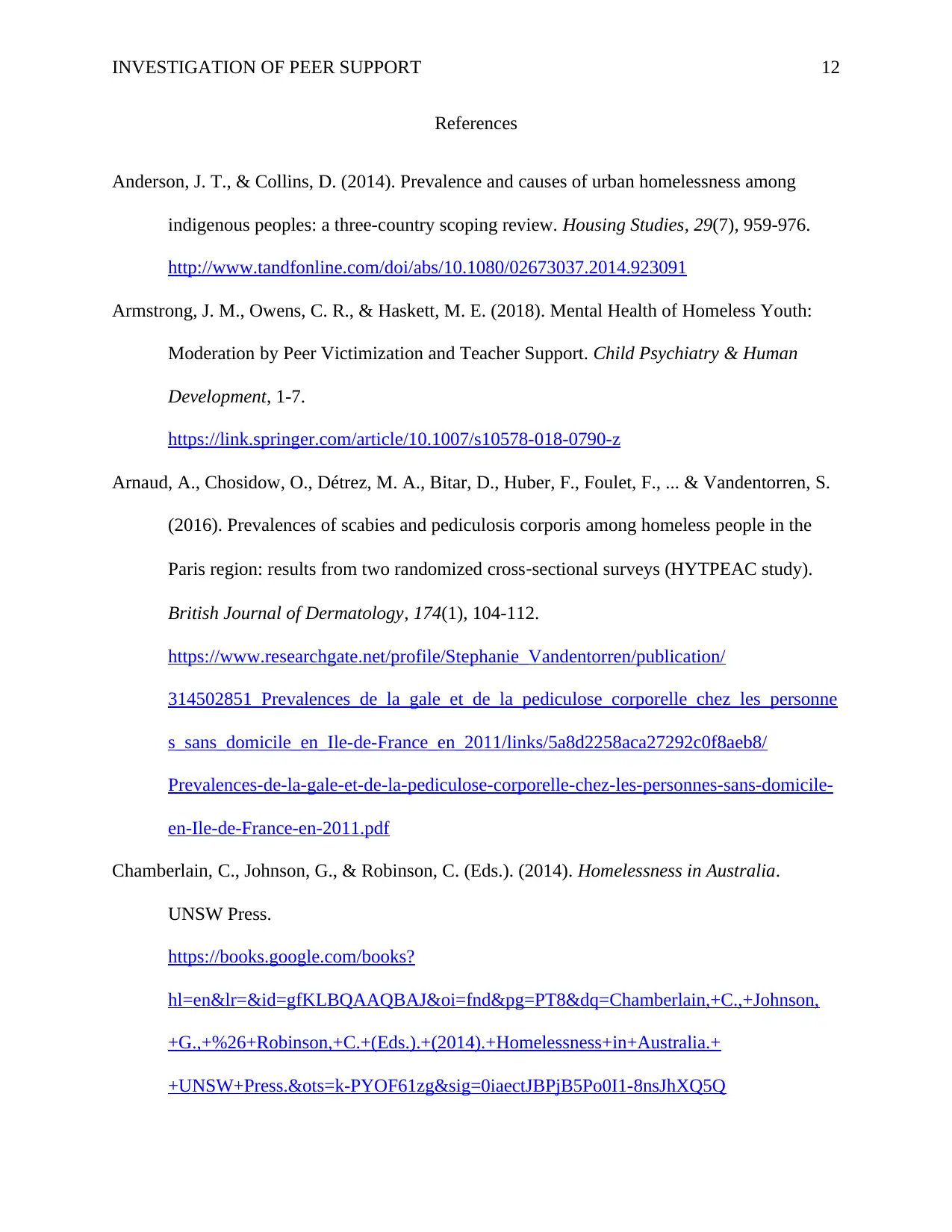
INVESTIGATION OF PEER SUPPORT 12
References
Anderson, J. T., & Collins, D. (2014). Prevalence and causes of urban homelessness among
indigenous peoples: a three-country scoping review. Housing Studies, 29(7), 959-976.
http://www.tandfonline.com/doi/abs/10.1080/02673037.2014.923091
Armstrong, J. M., Owens, C. R., & Haskett, M. E. (2018). Mental Health of Homeless Youth:
Moderation by Peer Victimization and Teacher Support. Child Psychiatry & Human
Development, 1-7.
https://link.springer.com/article/10.1007/s10578-018-0790-z
Arnaud, A., Chosidow, O., Détrez, M. A., Bitar, D., Huber, F., Foulet, F., ... & Vandentorren, S.
(2016). Prevalences of scabies and pediculosis corporis among homeless people in the
Paris region: results from two randomized cross‐sectional surveys (HYTPEAC study).
British Journal of Dermatology, 174(1), 104-112.
https://www.researchgate.net/profile/Stephanie_Vandentorren/publication/
314502851_Prevalences_de_la_gale_et_de_la_pediculose_corporelle_chez_les_personne
s_sans_domicile_en_Ile-de-France_en_2011/links/5a8d2258aca27292c0f8aeb8/
Prevalences-de-la-gale-et-de-la-pediculose-corporelle-chez-les-personnes-sans-domicile-
en-Ile-de-France-en-2011.pdf
Chamberlain, C., Johnson, G., & Robinson, C. (Eds.). (2014). Homelessness in Australia.
UNSW Press.
https://books.google.com/books?
hl=en&lr=&id=gfKLBQAAQBAJ&oi=fnd&pg=PT8&dq=Chamberlain,+C.,+Johnson,
+G.,+%26+Robinson,+C.+(Eds.).+(2014).+Homelessness+in+Australia.+
+UNSW+Press.&ots=k-PYOF61zg&sig=0iaectJBPjB5Po0I1-8nsJhXQ5Q
References
Anderson, J. T., & Collins, D. (2014). Prevalence and causes of urban homelessness among
indigenous peoples: a three-country scoping review. Housing Studies, 29(7), 959-976.
http://www.tandfonline.com/doi/abs/10.1080/02673037.2014.923091
Armstrong, J. M., Owens, C. R., & Haskett, M. E. (2018). Mental Health of Homeless Youth:
Moderation by Peer Victimization and Teacher Support. Child Psychiatry & Human
Development, 1-7.
https://link.springer.com/article/10.1007/s10578-018-0790-z
Arnaud, A., Chosidow, O., Détrez, M. A., Bitar, D., Huber, F., Foulet, F., ... & Vandentorren, S.
(2016). Prevalences of scabies and pediculosis corporis among homeless people in the
Paris region: results from two randomized cross‐sectional surveys (HYTPEAC study).
British Journal of Dermatology, 174(1), 104-112.
https://www.researchgate.net/profile/Stephanie_Vandentorren/publication/
314502851_Prevalences_de_la_gale_et_de_la_pediculose_corporelle_chez_les_personne
s_sans_domicile_en_Ile-de-France_en_2011/links/5a8d2258aca27292c0f8aeb8/
Prevalences-de-la-gale-et-de-la-pediculose-corporelle-chez-les-personnes-sans-domicile-
en-Ile-de-France-en-2011.pdf
Chamberlain, C., Johnson, G., & Robinson, C. (Eds.). (2014). Homelessness in Australia.
UNSW Press.
https://books.google.com/books?
hl=en&lr=&id=gfKLBQAAQBAJ&oi=fnd&pg=PT8&dq=Chamberlain,+C.,+Johnson,
+G.,+%26+Robinson,+C.+(Eds.).+(2014).+Homelessness+in+Australia.+
+UNSW+Press.&ots=k-PYOF61zg&sig=0iaectJBPjB5Po0I1-8nsJhXQ5Q
⊘ This is a preview!⊘
Do you want full access?
Subscribe today to unlock all pages.

Trusted by 1+ million students worldwide
1 out of 15
Related Documents
Your All-in-One AI-Powered Toolkit for Academic Success.
+13062052269
info@desklib.com
Available 24*7 on WhatsApp / Email
![[object Object]](/_next/static/media/star-bottom.7253800d.svg)
Unlock your academic potential
Copyright © 2020–2025 A2Z Services. All Rights Reserved. Developed and managed by ZUCOL.





